The Advantages of Using Multiplex PCR for the Simultaneous Detection of 14 Sexually Transmitted Diseases | Most advanced DNA test in Bangkok, Pattaya, Phuket, Thailand
4370
Asymptomatic testing, get tested even though you don't have any symptoms PCR Multiplex for 14 infections - Most advanced DNA test in Bangkok, Pattaya

Written by Dr.Deyn Natthakhet Yaemim (Founding Director) on 6 June 2015, Last updated 18 July 2022
The Advantages of Using Multiplex PCR for the Simultaneous Detection of Six Sexually Transmitted Diseases
1. Introduction
Sexually transmitted diseases (STDs) are an issue of great interest as they are among the most common of all infections. It is documented that STDs are more prevalent in economically underdeveloped populations. Only a few countries outside Western Europe and North America have implemented monitoring systems for these infections. In the rest of the world, epidemiological studies are based on the results of samples provided by certain population segments (mainly symptomatic patients or prenatal controls) not necessarily representative for the majority of the population. Usually, persons presenting obvious signs (secretions, lesions or pain) interrupt their sexual activity and seek medical help. Ironically, most often those who actually transmit these infections are asymptomatic or present mild symptoms [1].
It is well‐known that vaginal bacterial infections can induce human infertility, yet they are underestimated in infertility testing. Population screening and treatment of individuals presenting unexplained infertility that are detected as STD‐infected persons seem appropriate in this context [2].
No STD can be regarded as an isolated problem since multiple infections are rather common and STD infections generally denote a high‐risk sexual behavior that often can be associated with more serious infections. It is therefore important to acknowledge that STDs are often asymptomatic or cause nonspecific symptoms and that periodical STD testing is crucial in limiting the risk of human immunodeficiency virus (HIV) infection. STD control could significantly reduce HIV incidence worldwide, although the impact of interventions may vary depending on local epidemiological contexts. Analysis of data from several studies has suggested that a better management of STD cases is more likely to reduce HIV incidence in the early stages of an epidemic, when HIV infections are concentrated in population groups with a high prevalence of other curable STDs [3].
A correct STD diagnosis is needed to prevent further spreading of such infections in the healthy population. Several techniques and laboratory methods for highlighting these diseases were developed in the past decades. For instance, because of their high sensitivity, specificity and suitability for different types of samples, nucleic acid amplification tests (NAATs) are suitable for the diagnosis of urogenital infections. Lately, however, polymerase chain reaction (PCR) techniques are increasingly employed in such cases as they allow direct, sensitive, automated and usable detection of STD‐causing pathogens on all sample types and even the simultaneous detection of several STDs.
2. The most frequent causative agent of STDs
Chlamydia trachomatis is an intracellular human pathogen. C. trachomatis infection is the most common STD reported in Western Europe developed countries [4]. About 75% of all cases involve young people aged 15–24 years, being more common in women than in men. It infects the epithelial cells of the endocervix in women and the urethra in men. Infection with C. trachomatis is often asymptomatic, especially in women, but presents a high risk for complications. The treatment is rather simple if early detected. Of note, the bacteria can be passed from mother to newborn during delivery [5].
Urogenital infection with C. trachomatis shows a broad spectrum of clinical manifestations, including urethritis, cervicitis and pelvic inflammatory disease (PID). Intense mucosal inflammation is characterized by erythema, swelling and mucous secretions caused by mucopurulent cervicitis in women and nongonococcal urehtritis (NGU) in men. It is very important to diagnose these bacteria in early stages of infection and beginning treatment as soon as possible to prevent long‐term complications. It can persist in the genital tract for a long time, in a form that is resistant to immunodestruction; such symptoms are unnoticed in approximately 75–80% of women [6]. C. trachomatis genital infection significantly increases the risk of sequelae in the reproductive tract in women, including tubal deterioration, ectopic pregnancy and miscarriage [7]. The role of the C. trachomatis infection in decreasing male fertility is also well‐known. Given the severity of the complications, several countries (e.g., France) made recommendations for screening these bacteria in asymptomatic young subjects [8].
Neisseria gonorrhoeae is the etiologic agent of gonorrhea, one of the most common sexually transmitted bacterial infections, producing more than 82 million new infections worldwide each year [9]. N. gonorrhoeae or gonorrhea is an aerobic Gram‐negative bacterium presenting itself in the form of diplococci. Along with C. trachomatis, it is the most prevalent sexually transmitted bacterial infection. It causes urogenital mucosa infections in men and women, being a serious cause of morbidity. The disease is characterized by purulent inflammation of the urogenital system mucosa. It is also presumed that gonorrhea infection may increase susceptibility to HIV and its transmission [10].
Neisseria gonorrhoeae has developed mechanisms to alter the epithelial barriers in order to reach subepithelial tissues and colonize in the host organism. Emergence and spread of multiresistant N. gonorrhoeae strains and the absence of an effective vaccine are major problems worldwide. Gonococcal endocarditis is a rare (1–2%) but serious disease that occurs in patients with disseminated gonococcal infections, which are also rare (0.3–5%) [11].
Several data indicate the involvement of the gonococci in miscarriages. Screening and medical management of the N. gonorrhoeae infection, including screening of women visiting abortion centers, have been proposed in order to identify associated risk factors and to assess the benefits of systematic screening in avoiding complications [12].
Trichomonas vaginalis is the causative agent of trichomonosis, one of the nonviral STDs. This protozoan was first described in 1836 by Donné. Infection with this parasite can give birth to serious complications, especially in women. The spectrum of clinical presentation range from asymptomatic or slightly symptomatic, particularly in men, to severe vaginitis with abundant vaginal secretions in women [13]. Infections with this protozoan can lead to serious health problems such as infertility, preterm delivery, low birth weight [14, 15], susceptibility to cervical cancer [15] or increased prevalence of high risk human papillomavirus (HPV) infection [16]. Moreover, there is a strong association between T. vaginalis infection and acquisition of HIV [17]. Because it is sexually transmitted, trichomoniasis is common in populations at higher risk for other sexually transmitted infections. Its presence in an individual is a marker for high‐risk behaviors and coincident STDs should be sought after. This infection is detected in approximately three quarters of the infected women's male sex partners [18]. For better cure rates, sexual partners should be treated simultaneously even if the infection is asymptomatic.
Trichomonas vaginalis infects squamous epithelial cells through direct contact, producing micro‐ulcerations and microscopic bleedings in the vaginal walls and endocervix. In most cases, men are asymptomatic, but they transmit the infection to women. As the women's columnar epithelium is not affected, trichomonosis is manifest as vaginitis, but not endocervicitis. The simultaneous presence of an endocervicitis should alert the physician to check possible coinfections with C. trachomatis or N. gonorrhoeae. Severe infections are usually treated with nitroimidazole derivatives, but the number of resistant strains is constantly growing [19, 20].
The term mycoplasma is used to designate organisms in the Mollicutes class, the smallest free‐living cell‐wall‐deficient microorganisms, the most simple life forms capable of replication outside a host cell. Ureaplasma urealyticum, Ureaplasma parvum, Mycoplasma genitalium and Mycoplasma hominis are the most common species of mycoplasmas in both men and women. Mycoplasma species (U. urealiticum and M. hominis in particular) are frequently detected in sexually active asymptomatic youngsters. However, they can induce a broad spectrum of pathological conditions in both women and men, including unexplained chronic symptoms of lower urinary tract, NGU, PID, pyelonephritis, chronic prostatitis, preterm labor and idiopathic abortion due to infection of the urogenital bodies [21].
Ureaplasma species are sometimes detected in the commensal bacteria of the lower genital tract, so their role among STD is still questioned. Some studies demonstrated that the association of Ureaplasma species with NGU depends on the detected species and that U. urealiticum is an etiologic agent of NGU, unlike U. parvum. In addition, it is reported that U. urealyticum can cause infections in the lower genital tract and is a pathogen agent of urethritis in males [22]. In assessing the role of these microorganisms in producing human diseases, their high prevalence among asymptomatic individuals should be taken into consideration.
M. genitalium is a microorganism associated with acute and chronic sexually transmitted nongonococcal urethritis in men. Data regarding infections in women suggest that M. genitalium is associated with urethritis, cervicitis and PID. According to some authors, individuals with clinically‐significant urethritis, persistent PID or cervicitis should be tested for M. genitalium [23]. As in the case of C. trachomatis, M. genitalium infection is often asymptomatic.
Several authors have reported that these organisms are engaged in women infertility, preterm delivery, premature rupture of membranes and chorioamnionitis [24, 25]. In addition, some studies present mycoplasma as causative agents of male infertility. It has been reported that these infections change various sperm characteristics, such as motility, density or morphology, and that antibiotic treatment improves the quality of the sperm [26]. A recent study found out that detection rates of M. hominis and U. urealiticum in infertile couples were about two times higher than in fertile couples [27].
3.What infections can the PCR Multiplex at PULSE Clinic detect?
In people who has infection with symptom (symptomatic infection) and without symptoms (asymptomatic infections), DNA PCR TEST can detect;
- Chlamydia trachomatis (serovars A-K) which causes chlamydia
- Chlamydia trachomatis (serovars L1-L3) which causes LGV or Lymphogranuloma venereum
- Neisseria gonorrhoeae which causes Gonorrhea
- Trichomonas vaginalis which causes Trichomoniasis
- Mycoplasma hominis
- Mycoplasma genitalium (an emerging STI)
- Ureaplasma urealyticum (read more)
- Ureaplasma parvum (read more)
- Herpes Simplex Virus type I (read about Herpes Simplex Virus)
- Herpes Simplex Virus type II
- Treponema pallidum which causes syphilis
- Haemophilus ducreyi which causes chancroid
- Cytomegalovirus (CMV)
- Varicella-Zoster Virus (VZV)
4.WHICH BODY PART CAN I GET TESTED FOR ASYMPTOMATIC INFECTIONS USING DNA PCR TEST?
Let's think about how we use our part of body to give ourselves (and our partners) pleasure.
THROAT SWAB
Imagine we kiss and suck and all the oral sex we use our mouth (and tongue and throat) the infections can be localized on your tonsil glands.
So for this area we perform a swab, gently rubbing the swab (or small cotton bud) on the back of the throat, on the tonsils, and in any other area where there might be redness, inflammation or pus. Throat swab can detect 14 infections mentioned above. There are no risks or complications associated with a throat swab culture. The test may cause momentary gagging because the back of the throat is a sensitive area, but it shouldn’t be painful.
ANAL SWAB
Doesn't matter if you are a man, a girl or a transwoman, if you like it from the back or using your backdoor for some fun the infections from your partners (or toys, hands, or gloves when fisting) can localize on the surface of anal canal or rectal tissue surface. Don't be too embarrassed to discuss your anal sex and safe anal sex practices with your doctor (We've seen many holes before and you won't be the last). To collect the specimen, a small cotton swab (you wish it is bigger) is placed into the anal canal and the rectum. The swab is rotated gently, removed and put in a container to be sent to our lab. There may be pressure as the swab is inserted into the rectum. The test shouldn't cause you any pain, we are always gentle and handle with care.
VAGINAL SWAB
We're talking about woman and transwoman, vaginal canal can be a house to host STI party and a matter of fact, STIs amongst transwoman do not differ from the non-TG population unless there are other risks factors involved. To collect the specimen, a small cotton swab is placed into the vaginal canal. The swab is rotated gently, removed and put in a container to be sent to our lab.
Urine testing for STIs is becoming increasingly available. These days, 14 STIs can be detected using urine testing. Urine PCR test is a lot more pleasant than urethral or cervical swabs (the old technique which was painful and uncomfortable) and are quickly becoming standard practice. Urine testing, as opposed to swab testing, makes it easier for people to undergo STI testing as part of their regular medical care. To collect the specimen for testing, YOU JUST HAVE TO PEE!
Here are the steps starting from
Registration >> Receive label sticker and container >> go to the toilet
>> do not wipe or clean your penis/vagina >> open the urine cup >> pee the first stream urine until it’s filled halfway
>> place urine cup in specimen bag >> wash your hands with THANN hand wash and water
>> pass it to staff at the counter >> pay >> confirm email address >> Sashay away
Add us on Line and stay in touch.
Pricelist
| PCR for 14 Infections (STD Multiplex) | Online results | |||
| Same day | Next day | 3 days | 7 days | |
| Throat | 7200.- | 6990.- | 4990.- | 4690.- |
| Urine | 7200.- | 6990.- | 4990.- | 4690.- |
| Anal Swab | 7200.- | 6990.- | 4990.- | 4690.- |
| Vaginal Swab | 7200.- | 6990.- | 4990.- | 4690.- |
| Cervical Swab | 7200.- | 6990.- | 4990.- | 4690.- |
| Sperm | 7890.- | 7250.- | 5490.- | 5050.- |
| Skin Lesion Swab | 7200.- | 6990.- | 4990.- | 4690.- |
| Pooled Swab | 9400.- | 8600.- | 8290.- | 7750.- |
| PCR for 2 Infections (Gonorrhea/Chlamydia) | Same day | Next day | 3 days | 7 days |
| Throat | 5690.- | 4990.- | 3990.- | 3300.- |
| Urine | 5690.- | 4990.- | 3990.- | 3300.- |
| Vaginal and Cervical Swab | 5690.- | 4990.- | 3990.- | 3300.- |
| Rectal Swab | 5690.- | 4990.- | 3990.- | 3300.- |
| Skin lesion Swab | 5690.- | 4990.- | 3990.- | 3300.- |
| Sperm | 6200.- | 5150.- | 4100.- | 3690.- |
| Pooled Swab | 6990.- | 6400.- | 5790.- | 4590.- |
- Prices are in Thai Baht
- Price per one location of testing
- Online results will be available at PULSE Online Portal (POP) and E-Doc mobile application
Trust PULSE CLINIC to take care of your health like other 45000 people from over 130 countries. We provide discreet professional service with high privacy. Here to help, not to judge.







